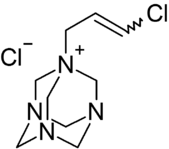季铵盐-15
外观
| 季铵盐-15 | |
|---|---|

| |
| IUPAC名 1-(3-Chloroallyl)-3,5,7-triaza-1-azoniaadamantane chloride 1-(3-氯代烯丙基)-3,5,7-三氮杂-1-氮𬭩金刚烷氯化物 | |
| 识别 | |
| CAS号 | 4080-31-3 51229-78-8(顺式) |
| PubChem | 6435993 |
| ChemSpider | 23621565 |
| SMILES |
|
| InChI |
|
| InChIKey | UKHVLWKBNNSRRR-REWHXWOFAS |
| 性质 | |
| 化学式 | C9H16Cl2N4 |
| 摩尔质量 | 251.16 g·mol−1 |
| 危险性 | |
GHS危险性符号   
| |
| H-术语 | H228, H302, H315, H317, H361, H411 |
| P-术语 | P210, P273, P280 |
| 若非注明,所有数据均出自标准状态(25 ℃,100 kPa)下。 | |
季铵盐-15(英语:Quaternium-15)是一种季铵盐,化学式为C9H16Cl2N4,可用作表面活性剂和防腐剂。它可充当抗微生物剂,因为它会缓慢释放甲醛,这是一种具有杀菌特性的防腐剂。
季铵盐-15和甲醛释放剂一直是受到争论的话题。它们在美国和欧洲经常被禁止使用。[1][2]
合成
[编辑]应用
[编辑]分离出的顺式异构体主要用于化妆品,欧盟的最大允许浓度为0.2%。混合产品可用于更广泛的配方,如可乳化金属切削液、乳胶和乳胶漆、液体地板抛光剂和地板蜡,以及胶水和粘合剂。
安全问题
[编辑]自2017年以来,欧盟已禁止使用季铵盐-15,美国正在考虑这项法案。[3][4]
过敏反应
[编辑]季铵盐-15是一种过敏原,可引起皮炎。[5]许多对 季铵盐-15过敏的人也对甲醛过敏。在低pH下,由于杜勒平反应的酸水解,预计会释放大量甲醛。可以使用贴布试验检测对季铵盐-15的敏感性。[6] 它是手部过敏性接触性皮炎的最常见原因(959例中占16.5%)。[7]在2005–2006年间,它是贴布试验中第四大流行的过敏原 (10.3%)。[8]
由于季铵盐-15会释放少量甲醛,[9]为了应对消费者的压力,强生公司宣布计划到2015年逐步停止在化妆品中使用季铵盐-15。[10][11]
参考资料
[编辑]- ^ de Groot, Anton C.; White, Ian R.; Flyvholm, Mari-Ann; Lensen, Gerda; Coenraads, Pieter-Jan. Formaldehyde-releasers in cosmetics: relationship to formaldehyde contact allergy. Contact Dermatitis. 2010, 62 (1): 2–17. PMID 20136875. S2CID 39758546. doi:10.1111/j.1600-0536.2009.01615.x.
- ^ De Groot, Anton; Geier, Johannes; Flyvholm, Mari-Ann; Lensen, Gerda; Coenraads, Pieter-Jan. Formaldehyde-releasers: Relationship to formaldehyde contact allergy, Part 2: Metalworking fluids and remainder. Contact Dermatitis. 22 June 2010, 63 (3): 129–139. PMID 20573163. S2CID 28278068. doi:10.1111/j.1600-0536.2010.01715.x.
- ^ European Commission notifies bans, restrictions on CMRS in cosmetics. [2 December 2019]. (原始内容存档于2021-01-03).
- ^ The cosmetics industry has avoided strict regulation for over a century. Now rising health concerns has FDA inquiring. [2 December 2019]. (原始内容存档于2023-01-17).
- ^ Cahill J, Nixon R. Allergic contact dermatitis to quaternium 15 in a moisturizing lotion. Australasia J Dermatol. 2005 Nov;46(4):284–5. PMID 16197434
- ^ New Zealand Dermatological Society. Quaternium-15 contact allergy. DermNet NZ. [2007-05-31]. (原始内容存档于2016-07-25).
- ^ E. Warshaw, et al. "Contact dermatitis of the hands: Cross-sectional analyses of North American Contact Dermatitis Group Data, 1994–2004". Journal of the American Academy of Dermatology, Volume 57, Issue 2, pp. 301–314
- ^ Zug, KA; Warshaw, EM; Fowler, JF Jr; Maibach, HI; Belsito, DL; Pratt, MD; Sasseville, D; Storrs, FJ; Taylor, JS; Mathias, CG; Deleo, VA; Rietschel, RL; Marks, J. Patch-test results of the North American Contact Dermatitis Group 2005–2006. Dermatitis. 2009, 20 (3): 149–60. PMID 19470301. S2CID 24088485. doi:10.2310/6620.2009.08097.
- ^ Formaldehyde. American Cancer Society. [3 March 2016]. (原始内容存档于2016-11-30).
- ^ Johnson & Johnson to phase out potentially harmful chemicals by 2015. CBS News. [3 March 2016]. (原始内容存档于2023-03-23).
- ^ Thomas, Katie. The 'No More Tears' Shampoo, Now With No Formaldehyde. The New York Times. 17 January 2014 [3 March 2016]. (原始内容存档于2023-03-23).
外部链接
[编辑]- Record in the Household Products Database of NLM
- Occupational Hazards - Quaternium-15 (页面存档备份,存于互联网档案馆)
